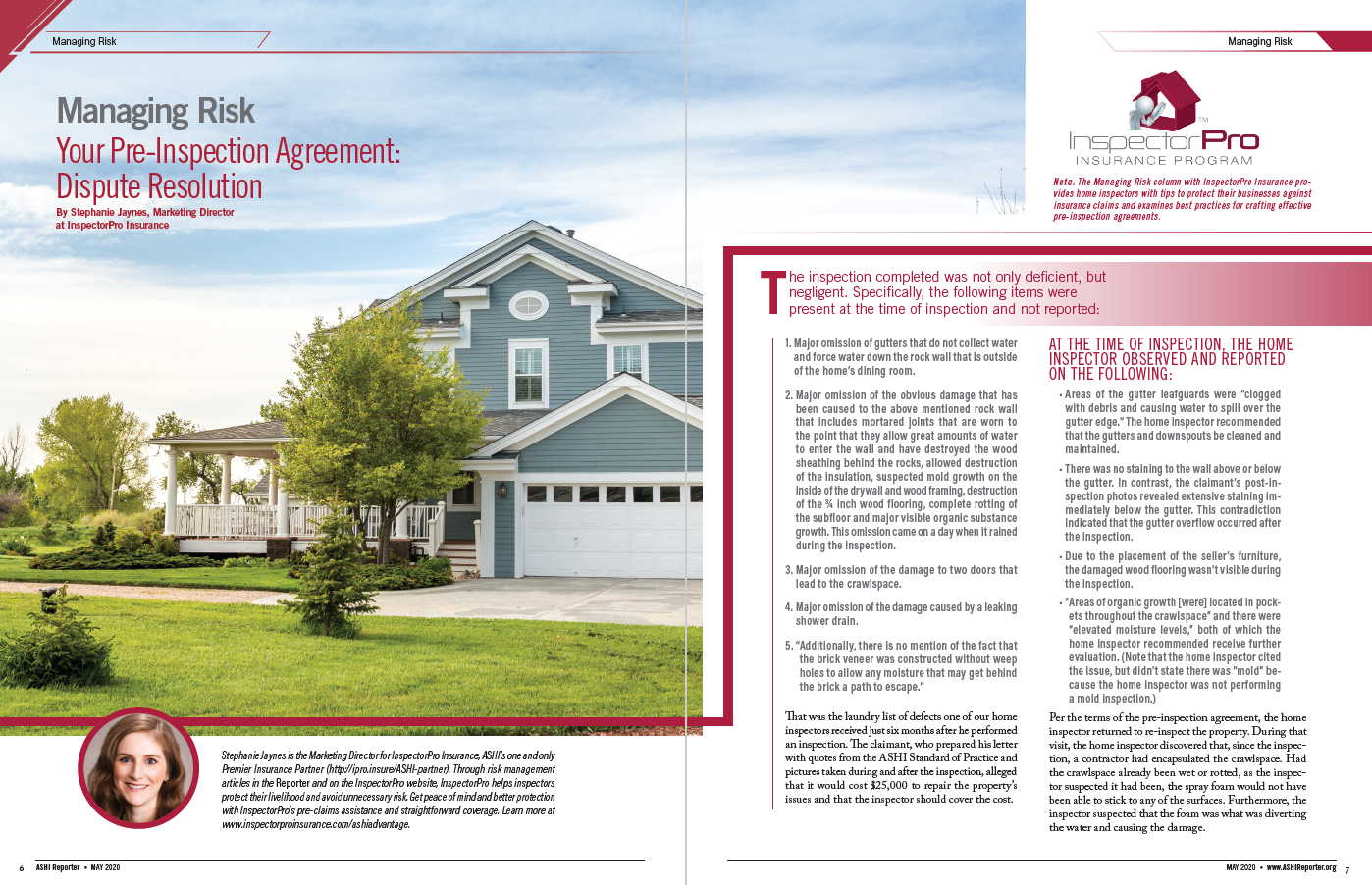Your Pre-Inspection Agreement: Dispute Resolution
Last Updated November 22, 2023

The following relates an inspection claim resolved with a dispute resolution provision. All identifiable characteristics removed for anonymity.
"The inspection completed was not only deficient, but negligent. Specifically, the following items were present at the time of inspection and not reported:
- Major omission of gutters that do not collect water and force water down the rock wall that is outside of the home's dining room.
- Major omission of the obvious damage that has been caused to the above mentioned rock wall that includes mortared joints that are worn to the point that they allow great amounts of water to enter the wall and have destroyed the wood sheathing behind the rocks, allowed destruction of the insulation, suspected mold growth on the inside of the drywall and wood framing, destruction of the 3/4 inch wood flooring, complete rotting of the sublfoor and major visible organic substance growth. This omission came on a day when it rained during the inspection.
- Major omission of the damage to two doors that lead to the crawlspace.
- Major omission of the damage caused by a leaking shower drain.
- Additionally, there is no mention of the fact that the brick veneer was constructed without weep holes to allow any moisture that may get behind the brick a path to escape."
 One of our home inspectors received that laundry list just six months after he performed an inspection. The claimant, who prepared his letter with quotes from the ASHI Standard of Practice and pictures taken during and after the inspection, alleged that it would cost $25,000 to repair the property’s issues and that the inspector should cover the cost. Using this example, we will break down dispute resolution methods.
One of our home inspectors received that laundry list just six months after he performed an inspection. The claimant, who prepared his letter with quotes from the ASHI Standard of Practice and pictures taken during and after the inspection, alleged that it would cost $25,000 to repair the property’s issues and that the inspector should cover the cost. Using this example, we will break down dispute resolution methods.
The Details of the Report
At the time of the inspection, the home inspector observed and reported on the following:
- Areas of the gutter leaf guards were "clogged with debris and causing water to spill over the gutter edge." The home inspector recommended that the gutters and downspouts be cleaned and maintained.
- There was no staining to the wall above or below the gutter. In contract, the claimant's post-inspection photos revealed extensive staining immediately below the gutter. This contradiction indicated that the gutter overflow occurred after the inspection.
- Due to the placement of the seller's furniture, the damaged wood flooring wasn't visible during the inspection.
- "Areas of organic growth [were] located in pockets throughout the crawlspace" and there were "elevated moisture levels," both of which the home inspector recommended receive further evaluation. (Note that the home inspector cited the issue but didn't state there was "mold" because he was not performing a mold inspection.
In addition to these observations, the home inspector also included a dispute resolution provision in his inspection agreement.
What is a dispute resolution provision?
Dispute resolution provisions specify just how clients should file claims. These provisions benefit home inspectors in many ways. Here are just two:
- Specifying an effective dispute resolution process can help close cases quickly. Clearly lay out processes in your agreement. It streamlines claims handling and response time. Additionally, resolution solutions such as small claims court and arbitration tend to be cheaper and faster than litigation. Thus, inspectors are more likely to resolve disputes promptly and with less impact to their insurance premiums.
- Dispute resolution provisions encourage motions to be filed close by. Often, claims are inconvenient. However, having to appear in a court far from your inspection area can be particularly cumbersome. Few mediators will honor dispute resolution provisions that order claimants to file in their inspectors’ county of residence. But most will recognize provisions that call for filings in the county in which their inspections took place.
What does a dispute resolution provision look like?
The following showcases a dispute resolution provision written by our claims team:

How can you write a dispute resolution provision for your pre-inspection agreement?
Provisions, like the one in this example, must have complementary provisions within the agreement so that, when taken in total, you have an enforceable contract. In other words, if you take this sample provision and simply add it to your existing agreement, there’s no assurance that the provision will be enforceable.
In fact, manufacturing an agreement with disparate pieces of material could make a contract less enforceable. Why? Most provisions contain specifics, including what services the inspection covers and how claimants must submit disputes. By inserting unvetted provisions into an existing agreement, you could create inconsistencies or contradictions throughout the agreement.
Recently in Florida, contradictory statements within an inspection agreement rendered the limitation of liability provision unenforceable. The judge deemed the provision “vague and ambiguous” because there were several contradictory statements throughout the agreement.
 Additionally, some states have specific laws regarding small claims court and arbitration. Legal assistance can help you cater your dispute resolution provision to whatever regulations exist in your area. They can also help you avoid incorporating a dispute resolution provision in locations where such provisions aren’t permissible.
Additionally, some states have specific laws regarding small claims court and arbitration. Legal assistance can help you cater your dispute resolution provision to whatever regulations exist in your area. They can also help you avoid incorporating a dispute resolution provision in locations where such provisions aren’t permissible.
Don’t risk having a judge dismiss any portion of your pre-inspection agreement for contradictions or lack of adherence to regulations. Be sure that any changes you make mesh with the rest of your contract and abide by local legislation. As you craft your agreement, we strongly recommend you consult a state licensed attorney that’s knowledgeable in contract law and the inspection industry.
Manage your risk against potential claims.
Let's return to our case study. The home inspector and our defense counsel attended the arbitration hearing. The arbiter ruled that “the inspector and the inspection report provided the necessary information to allow for proper repairs to be completed by the claimant to prevent the damages.” Furthermore, all claims made against the inspector were denied.
Because the claimant was unsuccessful in proving the inspector’s liability, the arbiter ruled that the claimant should pay all the defense expenses the inspector incurred. The arbiter awarded the inspector and us over $17,000 to cover arbitration charges, expenses, costs, and legal fees.
Ensure that claims go to courts and arbiters who understand the home inspection industry. You accomplish this by incorporating a dispute resolution provision, where permissible, and getting it and the rest of your pre-inspection agreement signed before every inspection. To learn more about arbitration clauses specifically, read the column next month when we will explore why arbitration is the preferred dispute resolution method for home inspectors.
Published in the ASHI Reporter in May 2020. See how this story appears in print below.







